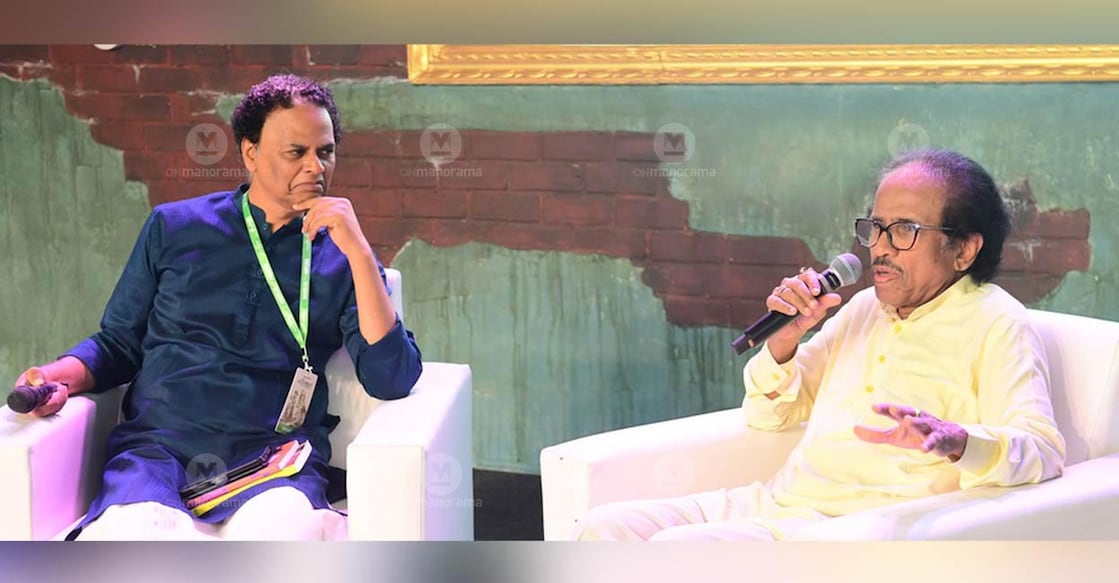How violinist L Subramaniam bridged the east-west divide in world music

Mail This Article
It was L Subramaniam's father, the legendary music teacher V Lakshminarayana, who had big ambitions for the violin.
In the early 20th century, violin was seen as an accompanying instrument. A violinist either played with a vocalist or supported a more prominent instrument like the veena.
"So my father's dream was to transform the instrument to solo status like in the western world where violinists like Lord Yehudi Menuhin were playing in the big orchestras," Subramaniam said at Manorama Hortus in Kozhikode on Saturday, November 2. "He wanted to hear Carnatic violin and Indian violin in those kinds of situations," the globally renowned violinist said.
L Subramaniam was taking part in the session 'Swaras and Stories' with Achuthsankar S Nair, a noted music scholar and Professor at the Department of Computational Biology & Bioinformatics, University of Kerala. Subramaniam's wife, the renowned playback singer Kavitha Krishnamurthy, was also present at the venue.
His father Lakshminarayana quickly spotted what stood in the way of his global ambition. "He realised there was a big gap in technical finesse and innovation. The average student in the west had a better technique than some of our most renowned violinists," Subramaniam said. "When you just play support, you don't develop technical virtuosity," he said. His father moved to Jaffna and began working on ways to improve the technical skills of his students. Subramaniam was fascinated by his father's efforts.
However, before bridging the gap between the east and the west, Subramaninam had to first close the north-south divide. "So I initially started doing 'jugalbandhis' with Ustad Ali Akbar Khan saheb, Bismillah Khan saheb and Alla Rakha ji and a lot of well-known North Indian artists," he said.
In those days, North Indian festivals very rarely had South Indian artists. But the South festivals always featured North artists. Once the north-south barrier was dismantled, Subramaniam set his sights across the ocean.
When he was 40, and India also turned 40, he got a rare opportunity to meet the legendary violinist Yehudi Menuhin. The year was 1987, and the occasion was India's 40th Independence celebrations. Both the violinists were supposed to play alone.
But Lord Menuhin sprang a surprise. "He asked me why don't you write a piece that we will play together," Subramanian said. It was this composition that he wrote for Menuhin, in Mohanaraga, that became the first instance of a musical bridge between the east and the west.
A minor reel-like portion from the Menuhin-Subramaniam 'jugalbandhi' of 1987, Subramaniam as Menuhin's musical sparring partner, was shown at the Hortus venue. "Without knowing Indian music, its concept or emotion, Menuhin could still understand the musicality of it," Subramaniam said.
For an untrained mind, Menuhin's sound felt sharper, reminding one of Japanese music played at a very high register. Subramanian's violin, on the other hand, scaled up from below, like a classical dancer shedding her subtle incipient diffidence to perform with complete abandon.
After the clip was played, Subramanian said: "Menuhin's ornamentation was not Indian. It was libretto (operatic). He was playing complete western ornamentation, and mine was Indian. We were playing in different octaves also".
Lord Menuhin would have been highly appreciative of Classical Indian music but it was not the case with the west in general. "They thought our music was folk music, primarily because we were sitting down an playing technically different music," Subramaniam said. "So always they referred to our music as part of World Music. Whereas classical music was only western classical music. They used to call it Occidental Music. Whenever they say Occidental Music, it was only western classical," Subramaniam said.
Over the years Subramaniam had sought to dispel primitive notions of Indian classical music. "Our classical music is one of the oldest, and perhaps the most sophisticated, systems in history. Just because we are sitting down and playing it doesn't mean that we are playing folk music or ethnic music though we have different types of folk and ethnic music in our country," Subramaniam said.
He said that the Indian classic system is based on 22 'shruthis', whereas the west has 12 tones on an octave. "For them the vertical motion of clusters of note played together creating harmony was their focus. Whereas we have 72 parent scales derived from over two million derived scales and we can go on creating new ragas. So our flexibility our improvisation ability to do things are far ahead, in that sense," he said.

